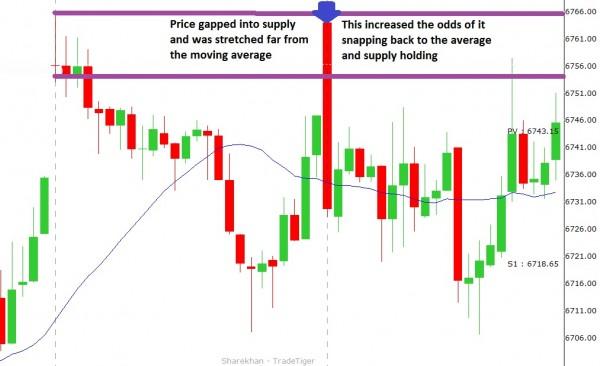Stretching the Price
|Most traders are familiar with moving averages. They are a useful technical tool for identifying the direction and strength of a trend. However, many traders overlook a very useful characteristic of price that allows us to identify a trading opportunity using moving averages. That characteristic is elasticity.
Prices are elastic. They will move away from an average and then snap back. They repeat this process in a trend over and over, stretching away from that average before returning. In a trend, however, the average will slowly move in the direction of the trend thus making the price cover less distance when retracing.
Imagine a rubber band. If you stretch the band slightly, it will snap back to its original shape. If you stretch the band further, you will have a more violent snap back to the original shape. Price acts in a similar manner. If you observe price stretching away from an average, it will snap back as soon as it strikes a level of supply or demand. Stretch price further, such as a parabolic move, and you will often experience a stronger return.
This elasticity is due to the actions and emotions of the people trading and investing in the stock/commodity/index/currency. It works the same on any security. If you go to the store and your favorite product is marked down on sale, you are more likely to buy it or even buy more of it. If inflation caused the price of the product to rise, you may buy less of it, not buy it at all, or look for a substitute to buy.
The same occurs with securities. When price is below the average price, it is undervalued and a bargain. If it moves to an extreme away from the average then it becomes irresistible to traders and investors who will rush in to buy it and send the price higher. The traders will stop buying when it reaches the average price since it is no longer a bargain. However, those who missed out on the initial buying spree may try to join and will push prices above the average. If prices extend too far above an average, then the price is overvalued and no one will want to buy it. Nervous holders of the security will start to sell and cause prices to drop to… you guessed it, the average.
In the chart, I have used a simple moving average to demonstrate this effect. Note how price will move away from the average and then return after reaching extremes. We can locate high probability long and short entries when this is combined with support and resistance. Typically, when price stretches away from the average, it will extend until it reaches a supply or demand level. These are levels where traders caused the price to reverse in the past. The over or undervalued nature of price being far from the average, added to the fact that the price has reached a level where it turned previously will usually lead traders to take that action again.
This gives us the opportunity to predict where traders will take action and more importantly, where we can profit by acting sooner. There are some important rules that you must keep in mind when trading. Always be mindful of the trend and do not trade against it. For instance, you shouldn’t buy in downtrends. Look to short or close shorts until you have confirmed the trend is reversing. You shouldn’t short in up-trends. Go long or exit according to your analysis. Learning to read price and its relationship to averages is a valuable skill that can be used to trade successfully in any market.
Information on these pages contains forward-looking statements that involve risks and uncertainties. Markets and instruments profiled on this page are for informational purposes only and should not in any way come across as a recommendation to buy or sell in these assets. You should do your own thorough research before making any investment decisions. FXStreet does not in any way guarantee that this information is free from mistakes, errors, or material misstatements. It also does not guarantee that this information is of a timely nature. Investing in Open Markets involves a great deal of risk, including the loss of all or a portion of your investment, as well as emotional distress. All risks, losses and costs associated with investing, including total loss of principal, are your responsibility. The views and opinions expressed in this article are those of the authors and do not necessarily reflect the official policy or position of FXStreet nor its advertisers.
